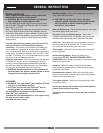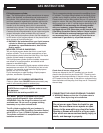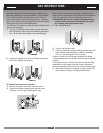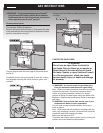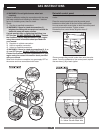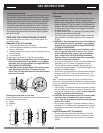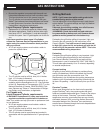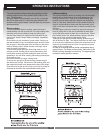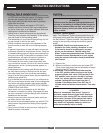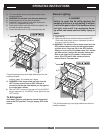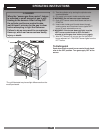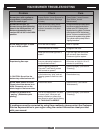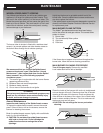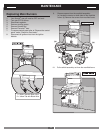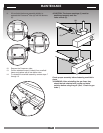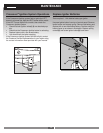Special offers from our partners!

Find Replacement BBQ Parts for 20,308 Models. Repair your BBQ today.

Buy Weber Grill Parts. It couldn't be easier. Find your Weber parts here.

1212
OPERATING INSTRUCTIONS
Grilling Tips & Helpful Hints
• Always preheat the grill before cooking. Set all burners
on HIGH heat and close lid; heat for 10 minutes, or until
thermometer registers 500˚-550˚F (260˚-288˚C).
• Sear meats and cook with the lid down for perfectly
grilled food every time.
• Grilling times in recipes are based on 70˚F (20˚C)
weather and little or no wind. Allow more cooking time
on cold or windy days, or at higher altitudes. Allow less
cooking time in extremely hot weather.
• Grilling times in charts and recipes are approximate.
Times can vary because of the weather, or the amount,
size and shape of the food being grilled.
• The temperature of your Summit
®
gas grill may run hot-
ter than normal for the fi rst few uses.
• Grilling conditions may require the adjustment of the
burner controls to attain the correct cooking tempera-
tures.
• In general, large pieces of meat will require more cook-
ing time per pound than small pieces of meat. Foods on
a crowded cooking grate will require more cooking time
than just a few foods. Foods grilled in containers, such
as baked beans, will require more time if grilled in a
deep casserole rather than a shallow baking pan.
• Trim excess fat from steaks, chops and roasts, leav-
ing no more than a scant 1⁄4 inch of fat. Less fat makes
cleanup easier, and is a virtual guarantee against un-
wanted fl are-ups.
• Foods placed on the cooking grate directly above burn-
ers may require turning or moving to a less hot area.
• Use tongs rather than a fork for turning and handling
meats to avoid losing natural juices. Use two spatulas for
handling large whole fi sh.
• If an unwanted fl are-up should occur, turn all burners to
OFF and move food to another area of the cooking grate.
Any fl ames will quickly subside. After fl ames subside,
relight the grill. NEVER USE WATER TO EXTINGUISH
FLAMES ON A GAS GRILL.
• Some foods, such as a casserole or thin fi sh fi llets,
will require a container for grilling. Disposable foil pans
are very convenient, but any metal pan with ovenproof
handles can also be used.
• Always be sure the bottom tray and grease catch pan
are clean and free from debris.
• Do not line the funnel-shaped bottom tray with foil. This
could prevent the grease from fl owing into the grease
catch pan.
• Using a timer will help to alert you when “well-done” is
about to become “over-done.”
Lighting
Summary lighting instructions are on the control panel.
ƽ DANGER
Failure to open the lid while igniting the barbecue's
burners, or not waiting 5 minutes to allow the gas to
clear if the barbecue does not light, may result in an
explosive fl ame-up which can cause serious bodily
injury or death.
Crossover
®
Ignition System
Note - The Crossover
®
ignition system ignites the set of
left burners with a spark from the igniter electrode inside
the Gas Catcher™ ignition chamber. You generate the
energy for the spark by pushing the electronic ignition
button.
ƽ WARNING: Check hose before each use of
barbecue for nicks, cracking, abrasions or cuts.
If the hose is found to be damaged in any way,
do not use the barbecue. Replace using only
Weber
®
authorized replacement hose. Contact the
Customer Service Representative in your region
using the contact information sheet provided with
your manual.
1) Open the lid.
2) Make sure all burner control knobs are turned OFF.
(Push control knob down and turn clockwise to ensure
that it is in the OFF position.)
ƽ WARNING: The burner control knobs must be
in the OFF position before turning on the liquid
propane cylinder tank valve. If they are not in the
OFF position, when you turn on the LP cylinder
valve, the “excess gas fl ow control” feature will
activate, limiting the fl ow of gas from the LP
cylinder. If this should occur, turn OFF the LP
cylinder valve and burner control knobs. Then start
over.
ƽ DANGER:
When the “excess gas fl ow control” feature is
activated, a small amount of gas is still fl owing to
the burners. After turning OFF the cylinder knobs,
wait at least 5 minutes for the gas to clear before
attempting to light the barbecue. Failure to do so
may result in an explosive fl ame-up, which can
cause serious bodily injury or death.



